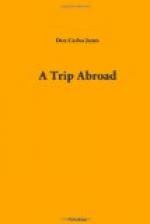The most interesting thing about the town is the “cave of Machpelah,” but it is inaccessible to Christians. Between 1167 and 1187 a church was built on the site, now marked by a carefully guarded Mohammedan mosque. It is inclosed by a wall which may have been built by Solomon. We were allowed to go in at the foot of a stairway as far as the seventh step, but might as well have been in the National Capitol at Washington so far as seeing the burial place was concerned. In 1862 the Prince of Wales, now King of England, was admitted. He was accompanied by Dean Stanley, who has described what he saw, but he was permitted neither to examine the monuments nor to descend to the cave below, the real burial chamber. As the body of Jacob was carefully embalmed by the Egyptian method, it is possible that his remains may yet be seen in their long resting place in this Hebron cave. (Gen. 50:1,2.)
Turning back toward Jerusalem, we came to Bethlehem late in the afternoon, and the “field of the shepherds” (Luke 2:8) and the “fields of Boaz” (Ruth 2:4-23) were pointed out. The place of greatest interest is the group of buildings, composed of two churches, Greek and Latin, and an Armenian convent, all built together on the traditional site of the birth of the Lord Jesus. Tradition is here contradicted by authorities partly on the ground that a cave to which entrance is made by a flight of stairs would probably not be used as a stable. This cave is in the Church of St. Mary, said to have been erected in 330 by Constantine. Descending the stairs, we came into the small cavern, which is continually lighted by fifteen silver lamps, the property of the Greeks, Latins, and Armenians, who each have an interest in the place. Beneath an altar, in a semi-circular recess, a silver star has been set in the floor with the Latin inscription: “Hic de Virgine Maria Jesus Christus Natus est.” An armed Turkish soldier was doing duty near this “star of Bethlehem” the evening I was there. The well, from which it is said the “three mighty men” drew water for David, was visited. (2 Samuel 23:15.) But the shades of night had settled down upon the little town where our Savior was born, and we again entered our carriages and drove back to Jerusalem, having had a fine day of interesting sight-seeing. On the Wednesday before I left Jerusalem, in the company of Mrs. Bates, I again visited Bethlehem.




